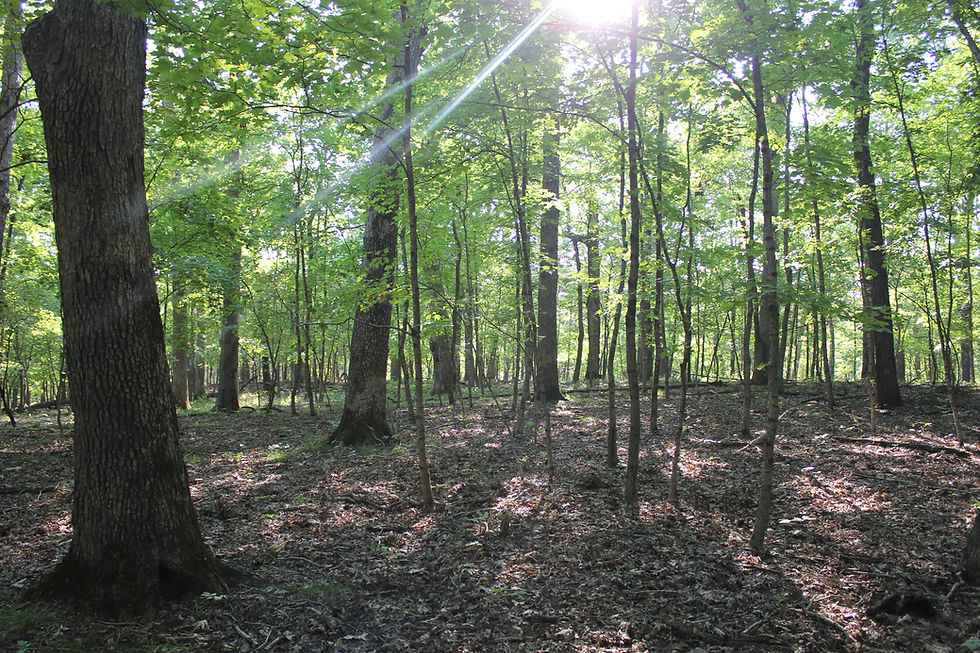Missouri maple syrup - a springtime tradition at BWREC
- Ben Knapp
- Mar 16, 2020
- 3 min read
Updated: Mar 17, 2020
Here in Missouri, we are not known for our maple syrup. We are located along the western and southern edge of the range of sugar maple (Acer saccharum) trees, which are typically found as a minor, mid-story component of our forests. Within the state, sugar maples are most abundant along the river hills of the Missouri River and are generally restricted to soils with relatively high pH (often underlain with limestone) and adequate water holding capacity.

Luckily, the Baskett Wildlife Research and Education Center happens to fall right within the sugar maple zone in the state. So each year, we organize students, faculty, staff, and friends to come out and tap approximately 200 sugar maple trees. While most of our sugar maples occur as small, mid-story trees, we have two stands of nearly pure sugar maple located in close proximity. These stands must have originated in response to a human land-use decision, as both also occur near an old home-site on the property and the concentration of sugar maples is a rarity.
Making Maple Syrup
The process for making maple syrup is pretty straight-forward. We typically tap the sugar maple trees in late January. To tap the trees, drill into the wood about 1.5 inches, with a very slight upward angle on the drill bit (to help the sap flow out). The spiles used may vary slightly but often around a 7/16" drill bit will work great. We use either 5-gallon plastic buckets or the 'sap sacks' for collecting sap out of the tree. The sap sacks are handy because they are easy to collect from and do a better job keeping precipitation and debris out of the buckets.
Trees will produce sap with the freezing and thawing weather cycle, so production is completely dependent on the weather. We have found that we get a good sap run with a substantial warm up event following a hard freeze, but we also get good, continuous sap production when the weather has daily fluctuations in the freeze and thaw cycle. In our case, we may need to visit the trees to collect sap from the buckets and bags once or twice per week. Once we get over 100 gallons of sap, we can have a boil event.
We use a two stage boil process. The first boil is done over a wood stove, which is designed to rapidly boil the sap down. During a full day of boiling, we can typically boil around 300 gallons of sap. Fresh sap is somewhere around 2-5% sugar, and we boil it down to around 40% sugar with the wood stove. We conduct the second boil over a smaller propane stove, so that we can quickly shut off the heat when the sap has been boiled long enough. For the final product, we aim to reach 66% sugar. The sugar content increases quickly when it is nearly finished, so the propane stove allows us to quickly turn off the heat. After boiling, we filter the syrup and bottle as quickly as possible!
Syrup at BWREC
Maple syrup production at BWREC is an opportunity to provide a learning experience for our students, with topics related to forest ecology, tree physiology, food production, and potentially business management. This project operates primarily through volunteer efforts, although we have supported one undergraduate student syrup internship each spring over

the past few years. The student interns are responsible for organizing project efforts and for collecting data on a subset of approximately 50 trees for sap collection. For each of these trees, we have data on tree size and record the amount of sap produced and the sugar content of the sap at each collection date. Some of these data were used to create a poster on the production process, presented at the Missouri Natural Resources Conference.
We have learned several things through the data collected by the student interns. For example, there is a lot of variability in the amount of sap produced among the trees of the sugar bush. Generally, bigger trees are capable of producing more sap than smaller trees, although we had poor sap producers across the full range of tree sizes. Good sap producers typically were consistently good throughout the year (at each collection date). From this information, we plan to apply some management to the sugar bush by thinning out the poor producers to provide more growing space to the good producers. We expect to increase production efficiency in this way.
I have had several recent trips to Canada and the northeastern US, and there is no doubt of the difference in scale between operations there and the hobby-farm operation here. To be sure, Missouri is not known for maple syrup. But we have a good reason to get together in the woods, get to know each other a bit better, and learn about something fun in the process. And I swear the syrup tastes just as good.





Comments